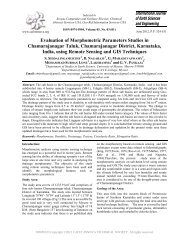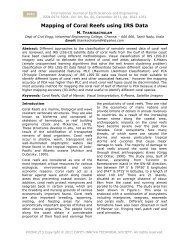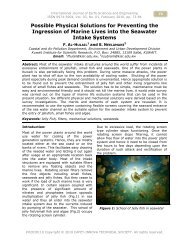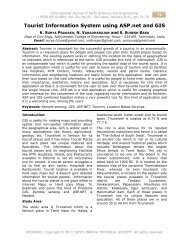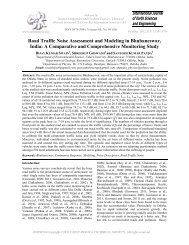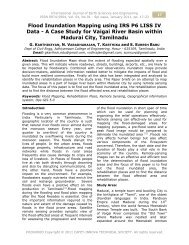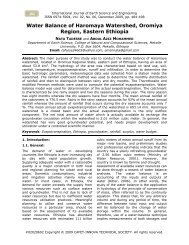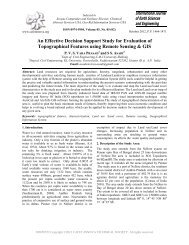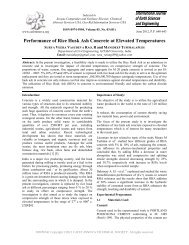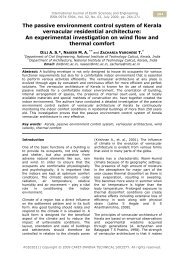Degradation of Paracetamol in Aqueous Solution by ... - Cafet Innova
Degradation of Paracetamol in Aqueous Solution by ... - Cafet Innova
Degradation of Paracetamol in Aqueous Solution by ... - Cafet Innova
Create successful ePaper yourself
Turn your PDF publications into a flip-book with our unique Google optimized e-Paper software.
International Journal <strong>of</strong> Earth Sciences and Eng<strong>in</strong>eer<strong>in</strong>gISSN 0974-5904, Vol. 04, No. 06, December 2011, pp. 1103-11101103<strong>Degradation</strong> <strong>of</strong> <strong>Paracetamol</strong> <strong>in</strong> <strong>Aqueous</strong> <strong>Solution</strong> <strong>by</strong>Fenton Oxidation and Photo-Fenton OxidationProcesses us<strong>in</strong>g Iron from Laterite Soil as CatalystBASAVARAJU MANU and MAHAMOODDepartment <strong>of</strong> Civil Eng<strong>in</strong>eer<strong>in</strong>g, National Institute <strong>of</strong> Technology Karnataka-NITK,Surathkal, P.O. Sr<strong>in</strong>ivasanagar– 575025, Mangalore-D.K, INDIAEmail: bmanu@nitk.ac.<strong>in</strong>; riazmahamood@gmail.comAbstract: For the treatment <strong>of</strong> paracetamol <strong>in</strong> water, the photo-Fenton Oxidation processand Classic Fenton oxidation process have been demonstrated and found effective. An ironcatalyst extracted from lateritic soil is used to exhibit the degradation and m<strong>in</strong>eralization <strong>of</strong>paracetamol. <strong>Paracetamol</strong> reduction and chemical oxygen demand (COD) removal aremeasured as the objective functions to be maximized. The experimental conditions <strong>of</strong> thedegradation <strong>of</strong> paracetamol are optimized <strong>by</strong> Fenton process. the optimum conditionsobserved for 10 mg/L <strong>in</strong>itial paracetamol concentration are <strong>in</strong>fluent pH 3, <strong>in</strong>itial H 2 O 2 dosage30 mg/L, [paracetamol]/[H 2 O 2 ] ratio 1:3 (w/w) and [H 2 O 2 ] / [Laterite iron] ratio 30:0.75(w/w). At the optimum conditions, for 10 mg/L <strong>of</strong> <strong>in</strong>itial paracetamol concentration , 76%paracetamol reduction and 69% COD removal <strong>by</strong> Fenton oxidation and 79% paracetamolreduction and 77% COD removal <strong>by</strong> UV-C Fenton process are observed <strong>in</strong> 120 m<strong>in</strong>utesreaction time. At the above optimum conditions, HPLC analysis has demonstrated 100%removal <strong>of</strong> paracetamol for Fenton oxidation process <strong>in</strong> 240 m<strong>in</strong>utes and for UV-C photo-Fenton process <strong>in</strong> 120 m<strong>in</strong>utes. The methods are effective and they may be used <strong>in</strong> theparacetamol <strong>in</strong>dustry.Keywords: <strong>Degradation</strong> <strong>of</strong> paracetamol; Fenton oxidation; Laterite soil; Photo-Fentonoxidation; UV-C lightIntroduction:Many chemical treatment techniques havebeen emerged <strong>in</strong> the last few decades todegrade non-biodegradable organicpollutants. Among these treatmenttechniques, the advanced oxidationprocesses appear to be promis<strong>in</strong>g andreported to be effective for the degradation<strong>of</strong> pharmaceuticals <strong>in</strong> waters. AdvancedOxidation Processes (AOPs) have provedcapable <strong>of</strong> completely degrad<strong>in</strong>g thepharmaceuticals from aqueous solutions(Klavarioti et al. 2009). These Processes arebased on the generation <strong>of</strong> hydroxyl radical,which is a powerful oxidant. Among AOPs,Fenton and Photo-Fenton Oxidationprocesses have emerged as the mostpromis<strong>in</strong>g methods for the treatment <strong>of</strong>organic non-biodegradable pollutants. In acomprehensive review, Neyens and Baeyens(2003) have <strong>in</strong>dicated that the Fenton’sOxidation is very effective <strong>in</strong> the removal <strong>of</strong>many hazardous organic pollutants fromwater and wastewaters. The photo-Fentonreaction <strong>in</strong>volves irradiation with solar or UVlight which significantly <strong>in</strong>creases the rate <strong>of</strong>pollutant degradation <strong>by</strong> photo reduction <strong>of</strong>Fe 3+ to Fe 2+ . Fenton’s reaction generateshydroxyl radicals and photo-Fentonreactions reduce the Fe 3+ to Fe 2+ , thuslead<strong>in</strong>g to production <strong>of</strong> additional OHradicals and cont<strong>in</strong>uous regeneration <strong>of</strong> Fe 2+<strong>in</strong> a catalytic way (Sun and Pignatello 1993).It is also observed that the additionalamounts <strong>of</strong> OH radicals are also producedfrom the direct photolysis <strong>of</strong> H 2 O 2 (Laat etal. 1999).Laterite soils are porous soil, coarse <strong>in</strong>texture and rich <strong>in</strong> m<strong>in</strong>erals like iron,alum<strong>in</strong>um, manganese and titanium butpoor <strong>in</strong> nitrogen, phosphoric acid, potashand lime. These soils are composed <strong>of</strong> ironoxides and hydrated alum<strong>in</strong>um with smallquantities <strong>of</strong> silica, manganese and titaniumoxides. This soil is common <strong>in</strong> India andmany other parts <strong>of</strong> the world.#02041220 Copyright © 2011 CAFET-INNOVA TECHNICAL SOCIETY. All rights reserved.
1104BASAVARAJU MANU and MAHAMOOD<strong>Paracetamol</strong> (4-hydroxyacetanilide or 4-acetamidephenol or acetam<strong>in</strong>ophen orTylenol) is extensively used as analgesic andantipyretic drug. <strong>Paracetamol</strong> is found to bepresent <strong>in</strong> sewage treatment plant (STP)effluents up to a concentration <strong>of</strong> 6 µg/L(Ternes 1998), up to 10 µg/L <strong>in</strong> watersamples from natural sources <strong>in</strong> USA(Buxton and Kolp<strong>in</strong> 2002) and more than 65µg/L <strong>in</strong> the Tyne River, UK (Roberts andThomas 2006). However, consequent to thesteep <strong>in</strong>crease <strong>in</strong> the usage, the production<strong>of</strong> paracetamol has also been <strong>in</strong>creasedmanifold all over the world and hence theconcentration <strong>of</strong> paracetamol may <strong>in</strong>crease<strong>in</strong> the waters.The aim <strong>of</strong> the present <strong>in</strong>vestigation is tostudy the paracetamol degradation andchemical oxygen demand (COD) removalefficiencies <strong>by</strong> Fenton and Photo-Fentonprocesses us<strong>in</strong>g the iron extracted fromlaterite soil as catalyst. It is observed thatthe UV-C light enhanced both thedegradation and m<strong>in</strong>eralization <strong>of</strong>paracetamol <strong>in</strong> water over Fenton oxidationand laterite soil may be used as an alternatesource <strong>of</strong> iron <strong>in</strong> Fenton reagent.Materials and Methods:Materials:<strong>Paracetamol</strong> Extra pure (98% assay) ispurchased from SD F<strong>in</strong>e Chem. Ltd. (India).Hydrogen Peroxide (H 2 O 2 ) (50% w/w) andFerrous Sulfate (FeSO 4 .7H 2 O) are purchasedfrom Merck (India). The chemicals are usedas received <strong>in</strong> the Fenton’s OxidationProcess. Hydrochloric acid (HCl, Merck,India, 35% purity), Sulfuric acid (H 2 SO 4 ,Merck, India, 98% purity), Sodiumhydroxide (NaOH, Merck, India, 98%purity), are also used <strong>in</strong> the experiments.Methanol AR grade (Merck, India), SodiumPentanesulfonate AR grade (Merck, India)and Formic acid AR grade (Merck, India) areused <strong>in</strong> HPLC analysis. The iron from lateritesoil is extracted us<strong>in</strong>g procedure given <strong>by</strong>Olanipekun (2000). The simulatedparacetamol aqueous stock solution <strong>of</strong> 1000mg/L concentration is prepared every weekwith Millipore Elix-3 deionized water andstored <strong>in</strong> the dark at 4 o C.Experimental Procedure:The oxidation experiments are carried out atambient temperature (27±3 o C) <strong>in</strong> batchreactors. Initially, the reaction conditionslike pH, H 2 O 2 dosage, and [H 2 O 2 ] / [Fe 2+ ]ratio are optimized <strong>in</strong> the Fenton oxidation<strong>of</strong> paracetamol and the further Fenton andphoto-Fenton experiments are conductedwith the optimum conditions. The effect <strong>of</strong><strong>in</strong>itial paracetamol concentration on thedegradation and m<strong>in</strong>eralization <strong>of</strong>paracetamol <strong>by</strong> both Fenton oxidation andUV-C Fenton oxidation are evaluated andthe results are compared. <strong>Paracetamol</strong>samples are analyzed us<strong>in</strong>g UV-Vis doublebeam spectrophotometer and highperformanceliquid chromatography (HPLC).All the Fenton and photo-Fentonexperiments are carried out <strong>in</strong> batchreactors. Figure 1 shows the photo-reactorconsists <strong>of</strong> enclosed chamber compris<strong>in</strong>g areactor (2L volume), 8W UV-C Philips lampcovered with a quartz jacket and connectedto AC power, magnetic stirrer. A 1000 mLsolution <strong>of</strong> required paracetamolconcentration is prepared from the stockparacetamol solution and is taken <strong>in</strong> the 2-liter reactor. Appropriate amount <strong>of</strong> ironconcentration from the 1000 mg/L stocksolution, which has been freshly preparedfrom the extract <strong>of</strong> laterite soil, is added tothe reactor bath and stirred with magneticstirrer. The <strong>in</strong>tr<strong>in</strong>sic pH <strong>of</strong> the wastewater is6.32 and the Initial pH 3 <strong>of</strong> the solutions isma<strong>in</strong>ta<strong>in</strong>ed us<strong>in</strong>g 0.1 N H 2 S0 4 and 0.1NNaOH. Required amount <strong>of</strong> H 2 O 2 is added tothe reactor bath to <strong>in</strong>itiate the reaction. Themixture <strong>of</strong> paracetamol solution andFenton’s reagent is stirred with magneticstirrer dur<strong>in</strong>g treatment. The paracetamolsolution samples are taken out for analysisat pre-def<strong>in</strong>ed time <strong>in</strong>tervals, filteredthrough 0.45-µm Millipore filter membranefor COD analysis, and filtered through a0.45-µm Millipore Syr<strong>in</strong>ge filter fordeterm<strong>in</strong>ation <strong>of</strong> paracetamol concentration<strong>by</strong> us<strong>in</strong>g UV-VIS Spectrophotometer andHPLC analysis.International Journal <strong>of</strong> Earth Sciences and Eng<strong>in</strong>eer<strong>in</strong>gISSN 0974-5904, Vol. 04, No. 06, December 2011, pp. 1103-1110
<strong>Degradation</strong> <strong>of</strong> <strong>Paracetamol</strong> <strong>in</strong> <strong>Aqueous</strong> <strong>Solution</strong> <strong>by</strong> Fenton Oxidation andPhoto-Fenton Oxidation Processes us<strong>in</strong>g Iron from Laterite Soil as Catalyst1105Figure 1: Schematic Representation<strong>of</strong> the Photochemical ReactorAnalytical Methods:UV-VIS spectrum is recorded from 190 to500 nm us<strong>in</strong>g UV-VIS spectrophotometerand the absorbance peak <strong>of</strong> paracetamol isobserved to be at wavelength 243 nm. Theconcentration <strong>of</strong> paracetamol <strong>in</strong> the aqueoussolution at wavelength 243 nm is measuredimmediately after removal <strong>of</strong> samples fromthe reactor us<strong>in</strong>g the standard curve, whichhas already been calibrated with UV-VISdouble beam spectrophotometer. The pH ismeasured with a digital pH meter (Lovibond– pH 100). The COD <strong>of</strong> the samples isdeterm<strong>in</strong>ed <strong>by</strong> closed reflux titrimetricmethod as per the procedure outl<strong>in</strong>ed <strong>in</strong> theStandard Methods (APHA 2005). The <strong>in</strong>itialCOD before treatment is due to paracetamol<strong>in</strong> synthetic wastewater and the COD aftertreatment is due to residual paracetamol ifpresent and other reaction <strong>in</strong>termediates, ifany, present <strong>in</strong> the aqueous solution. F<strong>in</strong>alCOD is quantitatively corrected for hydrogenperoxide <strong>in</strong>terference accord<strong>in</strong>g to thecorrelation equation given <strong>by</strong> Kang et al.(1999). The Iron concentration is measured<strong>by</strong> Thiocynate-colorimetric Method us<strong>in</strong>gSpectrocolorimeter (PC Spectroll, Lovibond).The H 2 O 2 concentration is determ<strong>in</strong>ed <strong>by</strong>iodometric titration method (Kolth<strong>of</strong>f 1920).HPLC analysis is carried out with reversedphaseJasco High Performance LiquidChromatograph fitted with Microbonda 5µm, 300 x 4.6 mm column at a temperature<strong>of</strong> 30 o C and coupled with a Jasco UV-2075plus <strong>in</strong>telligent UV-VIS Photodiode arraydetector selected at 243 nm, controlledthrough Jasco Chromatography data system.The mobile phase employed for paracetamolis 0.1 mg/mL <strong>of</strong> Sodium Pentanesulfonate atflow rate <strong>of</strong> 1.5 mL/m<strong>in</strong>ute. Theparacetamol solution samples are <strong>in</strong>jected atthe rate <strong>of</strong> 15 µL and acquisition time is setas 30 m<strong>in</strong>utes.Results and Discussion:Fenton Oxidation Process:Effect <strong>of</strong> pH:The experiments are conducted at differentpH values vary<strong>in</strong>g from 2 to 5.5 with <strong>in</strong>itialparacetamol concentration <strong>of</strong> 10 mg/L,[H 2 O 2 ] o 20 mg/L and [Fe 2+ ] o 2 mg/L. Theferrous sulfate is used as source <strong>of</strong> iron <strong>in</strong>these experiments. The maximumparacetamol reduction and COD removal arefound to be 78% and 75% respectively atpH 3. The paracetamol removal efficienciesare less for the other values <strong>of</strong> pH.At pH 3, <strong>Paracetamol</strong> removal is maximumand it may be due to the formation <strong>of</strong> moreFe(OH) + which has much higher activitythan Fe 2+ <strong>in</strong> Fenton’s oxidation (Badawy andAli 2006). When pH > 3, oxidationefficiency rapidly decreases due to autodecomposition<strong>of</strong> H 2 O 2 affect<strong>in</strong>g theproduction <strong>of</strong> OH radicals (Badawy and Ali2006) and deactivation <strong>of</strong> ferrous catalystwith the formation <strong>of</strong> ferric hydroxideprecipitates (Luis et al. 2009). When pH
1106BASAVARAJU MANU and MAHAMOODFigure 2: Variations <strong>in</strong> (a) Percent <strong>Paracetamol</strong> Reduction, (b) Percent COD Removal forvary<strong>in</strong>g H 2 O 2 Dosage from 10-50 mg/L and vary<strong>in</strong>g [Laterite Iron] from0.25 to 1.25 mg/L, (pH 3, [<strong>Paracetamol</strong>] o 10 mg/L)The reaction (1) given below describes thecomplete m<strong>in</strong>eralization <strong>of</strong> paracetamol <strong>in</strong>the Fenton’s Oxidation process.C8H9NO2+ 21H2O2+ Fe(II ) → 8CO2+ 25H2O+ HNO3+ Fe(II ) (1)The quantity <strong>of</strong> hydrogen peroxide required,based on Stoichiometric conditions, for thecomplete m<strong>in</strong>eralization <strong>of</strong> paracetamol is4.72 mg <strong>of</strong> H 2 O 2 per 1 mg <strong>of</strong> paracetamol.Stoichiometrically, 47.2 mg/L H 2 O 2 isrequired for the complete oxidation <strong>of</strong> 10mg/L <strong>of</strong> paracetamol. However, <strong>in</strong> thisFenton treatment with H 2 O 2 concentration <strong>of</strong>30 mg/L, the maximum paracetamolreduction and COD removal are observed.The results obta<strong>in</strong>ed for the removalefficiencies may be related to the <strong>in</strong>completem<strong>in</strong>eralization and the presence <strong>of</strong><strong>in</strong>termediates <strong>in</strong> the aqueous solution.Initially, the removal efficiency is <strong>in</strong>creasedwith <strong>in</strong>crease <strong>in</strong> H 2 O 2 concentration andfurther <strong>in</strong>crease <strong>in</strong> the H 2 O 2 concentrationresults <strong>in</strong> <strong>in</strong>crease <strong>of</strong> the residual H 2 O 2concentration. This is because <strong>of</strong> thescaveng<strong>in</strong>g <strong>of</strong> OH radicals with <strong>in</strong>crease <strong>in</strong>the H 2 O 2 concentration. It can be expla<strong>in</strong>ed<strong>by</strong> the fact that the very reactive OHradicals are consumed <strong>by</strong> H 2 O 2 that results<strong>in</strong> the generation <strong>of</strong> less reactive OOHradical and the hydroxyl radical is scavenged<strong>by</strong> the OH radical reaction with another OHradical to form water.The paracetamol reduction and CODremoval are <strong>in</strong>creased up to 80% and 75%respectively with the addition <strong>of</strong> laterite ironto the solution. Figure 2(a) -2(b) shows thevariations <strong>in</strong> percent paracetamol reductionand COD removal under the differentconditions <strong>of</strong> the laterite iron and H 2 O 2ma<strong>in</strong>ta<strong>in</strong><strong>in</strong>g pH <strong>of</strong> 3, reaction time <strong>of</strong> 24hours. The max paracetamol reduction andCOD removal are observed to be 80% and75% respectively at 0.75 mg/L laterite ironconcentration. These results are <strong>in</strong>agreement with the literature, where <strong>in</strong> an<strong>in</strong>crease <strong>in</strong> ferrous ion concentration <strong>of</strong>Fenton’s reagent <strong>in</strong>creases OH radicalproduction and hence the degradation andm<strong>in</strong>eralization (Yilmaz et al. 2010). It hasalso been observed that at higher lateriteiron concentrations the paracetamol andCOD removals are reduced. This may bedue to the iron ion <strong>in</strong>hibition that occurswhen high concentration <strong>of</strong> laterite iron ionsis present <strong>in</strong> the system and laterite ironions itself can react with OH radicalsresult<strong>in</strong>g the scaveng<strong>in</strong>g <strong>of</strong> OH radical.International Journal <strong>of</strong> Earth Sciences and Eng<strong>in</strong>eer<strong>in</strong>gISSN 0974-5904, Vol. 04, No. 06, December 2011, pp. 1103-1110
<strong>Degradation</strong> <strong>of</strong> <strong>Paracetamol</strong> <strong>in</strong> <strong>Aqueous</strong> <strong>Solution</strong> <strong>by</strong> Fenton Oxidation andPhoto-Fenton Oxidation Processes us<strong>in</strong>g Iron from Laterite Soil as Catalyst1107Effect <strong>of</strong> Initial <strong>Paracetamol</strong> Concentration:Figure 3: Variations <strong>in</strong> (a) Percent <strong>Paracetamol</strong> (PCM) Reduction and (b) Percent CODRemoval at [<strong>Paracetamol</strong>] o : [H 2 O 2 ] o : [Laterite Iron] o = 10:30:0.75 (w/w) , Fenton ProcessExperiments are conducted to study theeffect <strong>of</strong> <strong>in</strong>itial paracetamol concentrationson the Fenton’s oxidation process <strong>by</strong> vary<strong>in</strong>g<strong>in</strong>itial concentration from 10 - 50 mg/L for areaction time <strong>of</strong> 240 m<strong>in</strong>utes. Theparacetamol reduction is <strong>in</strong>creased and CODremoval is decreased with the <strong>in</strong>crease <strong>in</strong><strong>in</strong>itial concentration <strong>of</strong> paracetamol. Thisresult is comparable with the literature,where COD removal <strong>of</strong> pharmaceuticalwastewater <strong>by</strong> Fenton’s Oxidation is morefor the lower <strong>in</strong>itial concentrations <strong>of</strong> drugsUV-C Fenton Oxidation Process:(Yilmaz et al. 2010). Figure 3 (a)-3(b)shows the variations <strong>in</strong> percent paracetamolreduction and COD removals at[paracetamol] o /[H 2 O 2 ] o ratio 1:3 (w/w)[H 2 O 2 ] o /[Laterite iron] o ratio 30:0.75 (w/w),pH 3 for 240 m<strong>in</strong>utes <strong>of</strong> reaction time. 77%<strong>of</strong> paracetamol reduction and 71% <strong>of</strong> CODremoval are observed for 10 mg/L <strong>in</strong>itialconcentration <strong>of</strong> paracetamol, at H 2 O 2 <strong>of</strong> 30mg/L, laterite iron <strong>of</strong> 0.75 mg/L <strong>in</strong> 240m<strong>in</strong>utes <strong>of</strong> reaction time.Figure 4: Variations <strong>in</strong> (a) Percent <strong>Paracetamol</strong> (PCM) Removal and (b) Percent CODRemoval, UV-C Photo-Fenton Process, [PCM]: 10 – 50 mg/L [<strong>Paracetamol</strong>]o: [H 2 O 2 ] o: [Fe 2+ ] o= 10:30:0.75 (w/w), pH 3UV-Fenton experiments for the effect <strong>of</strong><strong>in</strong>itial paracetamol concentrations areconducted with paracetamol concentrationvary<strong>in</strong>g from 10 mg/L to 50 mg/L, optimumratio <strong>of</strong> [paracetamol] o :[H 2 O 2 ] o :[lateriteiron] o ::10:30:0.75 (w/w), which has beenobserved <strong>in</strong> our studies with Fenton’soxidation, pH 3 and the UV irradiation timeInternational Journal <strong>of</strong> Earth Sciences and Eng<strong>in</strong>eer<strong>in</strong>gISSN 0974-5904, Vol. 04, No. 06, December 2011, pp. 1103-1110
1108BASAVARAJU MANU and MAHAMOOD120 m<strong>in</strong>utes. Figure 4 shows the variations<strong>in</strong> percent paracetamol reduction and CODremovals at [paracetamol] o /[H 2 O 2 ] o ratio 1:3(w/w) [H 2 O 2 ] o /[Laterite iron] o ratio 30:0.75(w/w, pH 3 and 120 m<strong>in</strong>utes <strong>of</strong> reactiontime. The paracetamol reduction and CODremoval are observed as 73% and 58%respectively <strong>in</strong> 5 m<strong>in</strong>utes UV irradiationtime, whereas 79% <strong>of</strong> <strong>Paracetamol</strong>reduction and 77% <strong>of</strong> COD removal areobserved <strong>in</strong> 120 m<strong>in</strong>utes <strong>of</strong> UV irradiationtime for 10 mg/L <strong>in</strong>itial concentration <strong>of</strong>paracetamol. With the <strong>in</strong>crease <strong>in</strong>paracetamol concentration from 10 to 50mg/L, the drug degradation is <strong>in</strong>creasedfrom 79% to 90% and the COD removal isdecreased to 42% from 77%. This result is<strong>in</strong> accordance with the literature, whereCOD removal <strong>of</strong> pharmaceutical wastewater<strong>by</strong> UV-Fenton Oxidation is more for thelower <strong>in</strong>itial concentrations <strong>of</strong> pollutant (Deviet al. 2009). This phenomenon <strong>of</strong> decrease<strong>in</strong> COD removal with <strong>in</strong>crease <strong>in</strong> <strong>in</strong>itialparacetamol concentration is associated withthe characteristics <strong>of</strong> UV visible absorptionspectrum <strong>of</strong> the paracetamol (λ max =243 nm)that is significant near 254 nm (UV-C light isused) and hence the solution with higherdrug concentration absorbs a moresignificant fraction <strong>of</strong> the emitted UV light at254 nm than that with a lower <strong>in</strong>itialconcentration, as a result the number <strong>of</strong>available photons decreases lead<strong>in</strong>g to adecrease <strong>in</strong> the formation <strong>of</strong> OH radicals(Feng et al. 2003).Comparison between Fenton and Photo-Fenton Process:By analyz<strong>in</strong>g the results, it is observed thatthe paracetamol degradation efficiencies aremore <strong>in</strong> the case <strong>of</strong> UV-Fenton oxidationover the Fenton oxidation. Figure 5 showsthe comparison <strong>of</strong> (a) percent paracetamolreduction and (b) percent COD removalbetween Fenton oxidation and UV-Fentonoxidation. 3% more paracetamol reductionand 8% more COD removal are observed forUV-C photo-Fenton over Fenton oxidationfor 10 mg/L <strong>of</strong> <strong>in</strong>itial paracetamolconcentration <strong>in</strong> 120 m<strong>in</strong>utes reaction time.The reason for more degradation andm<strong>in</strong>eralization <strong>of</strong> paracetamol may be due toregeneration <strong>of</strong> Fe 2+ ions <strong>in</strong> photo-Fentonoxidation and <strong>in</strong> turn production <strong>of</strong> more OHradicals which has m<strong>in</strong>eralized moreamounts <strong>of</strong> parent drug and the<strong>in</strong>termediates formed <strong>in</strong> the reaction.Table 1: Comparison <strong>of</strong> the Literature Results with the Present StudyReferenceMethodResults<strong>Degradation</strong> M<strong>in</strong>eralization Reaction timeAndreozzi et al. Ozonation 30% 120 m<strong>in</strong>(2003)H 2 O 2 / UV 40% 120 m<strong>in</strong>Sires et al. (2006) Electrochemical98% 360 m<strong>in</strong>Skoumal et al. (2006)83% 240 m<strong>in</strong>Dalmazio et al. (2008)90% 160 m<strong>in</strong>TiO 2 /UVYang, et al., (2008) 95% 80 m<strong>in</strong>Isariebel et al.(2009) Sonolysis 100% 39% 480 m<strong>in</strong>Present studyH 2 O 2 /lateriteiron100% 71% 240 m<strong>in</strong>H 2 O 2 /lateriteiron/UV-C100% 77% 120 m<strong>in</strong>There are limited number <strong>of</strong> works reportedon the advanced oxidation <strong>of</strong> paracetamol<strong>by</strong> different methods (Andreozzi et al. 2003;Sires et al. 2006; Skoumal et al. 2006;Dalmazio et al. 2008; Yang et al. 2008;Isriebel et al. 2009) . The Table 1 consists<strong>of</strong> the comparison <strong>of</strong> present study withsome important results <strong>in</strong> literature. In thepresent study, HPLC analysis hasdemonstrated 100% degradation <strong>of</strong>paracetamol for photo-Fenton process <strong>in</strong>120m<strong>in</strong>utes and for Fenton process <strong>in</strong> 240m<strong>in</strong>utes. The correspond<strong>in</strong>g COD removalsare observed to be 71% for Fenton processInternational Journal <strong>of</strong> Earth Sciences and Eng<strong>in</strong>eer<strong>in</strong>gISSN 0974-5904, Vol. 04, No. 06, December 2011, pp. 1103-1110
<strong>Degradation</strong> <strong>of</strong> <strong>Paracetamol</strong> <strong>in</strong> <strong>Aqueous</strong> <strong>Solution</strong> <strong>by</strong> Fenton Oxidation andPhoto-Fenton Oxidation Processes us<strong>in</strong>g Iron from Laterite Soil as Catalyst1109<strong>in</strong> 240 m<strong>in</strong>utes and 77% for photo-Fentonprocess <strong>in</strong> 120 m<strong>in</strong>utes. As compared withprevious studies, the extent <strong>of</strong> thedegradation and m<strong>in</strong>eralization <strong>in</strong> 120 m<strong>in</strong>obta<strong>in</strong>ed <strong>in</strong> the present study are greaterthan the most <strong>of</strong> the literature studies dueto optimized conditions and UV-C lighteffectiveness <strong>in</strong> photo-Fenton oxidation.Figure 5: Comparison for (a) Percent <strong>Paracetamol</strong> (PCM) Removal and (b) Percent CODRemoval between Fenton and Photo-Fenton Processes, [<strong>Paracetamol</strong>]o: [H 2 O 2 ] o: [Fe 2+ ] o= 10:30:0.75 (w/w), [PCM] 10 mg/L, pH 3Conclusions:UV-C light enhanced the photo-Fentonoxidation <strong>of</strong> paracetamol and the process ismore efficient over Fenton oxidation. It isdemonstrated <strong>by</strong> the Fenton process thatthe optimum conditions to treat 10 mg/Lparacetamol concentration are pH 3, [H 2 O 2 ]30 mg/L, [laterite iron] 0.75 mg/L. At theoptimum conditions, for 10 mg/L <strong>of</strong> <strong>in</strong>itialparacetamol concentration , 76%paracetamol reduction and 69% CODremoval <strong>by</strong> Fenton oxidation and 79%paracetamol reduction and 77% CODremoval <strong>by</strong> UV-C Fenton process areobserved <strong>in</strong> 120 m<strong>in</strong>utes reaction time.HPLC analysis has demonstrated completedegradation <strong>of</strong> paracetamol for photo-Fenton process <strong>in</strong> 120m<strong>in</strong>utes and forFenton process <strong>in</strong> 240 m<strong>in</strong>utes. Ascompared to the works <strong>in</strong> literature, thepresent study is most effective <strong>in</strong>degradation and m<strong>in</strong>eralization <strong>of</strong>paracetamol. UV-Fenton process is observedto be an effective treatment method overFenton process for the removal <strong>of</strong>paracetamol <strong>in</strong> aqueous solutions. Fenton’soxidation process may be applied <strong>in</strong>-situ forthe treatment <strong>of</strong> paracetamol <strong>in</strong> surfacewater, ground water and lateritic soils.Acknowledgements:The authors gratefully acknowledge theesteemed pharmaceutical company,SeQuent Scientific Limited, 120 A&B,Industrial area, Baikampady, NewMangalore, India, for their HPLC analyticalservices.References:[1] Andreozzi, R., Caprio, V., Marotta, R. &Vogna, D. (2003). <strong>Paracetamol</strong> oxidationfrom aqueous solutions <strong>by</strong> means <strong>of</strong>ozonation and H 2 O 2 /UV system. WaterRes. 37, 993-1004.[2] APHA, AWWA, WEF.(2005). Standardmethods for the Exam<strong>in</strong>ation <strong>of</strong> Waterand Wastewater, 21 st ed., Wash<strong>in</strong>gton,DC USA.[3] Badawy, M. I. & Ali, M. E. M. (2006).Fenton’s peroxidation and coagulationprocesses for the treatment <strong>of</strong> comb<strong>in</strong>ed<strong>in</strong>dustrial and domestic wastewater. J.Hazard. Mater. 136, 961-966.[4] Buxton, H. & Kolp<strong>in</strong>, D.W. (2002).Pharmaceuticals, Hormones, and OtherOrganic Wastewater Contam<strong>in</strong>ants <strong>in</strong>U.S. Streams, Fact Sheet FS-027-02,United States Geological Surveyhttp://toxics.usgs.gov/pubs/FS-027-02,(Accessed on April 22, 2010).International Journal <strong>of</strong> Earth Sciences and Eng<strong>in</strong>eer<strong>in</strong>gISSN 0974-5904, Vol. 04, No. 06, December 2011, pp. 1103-1110
1110BASAVARAJU MANU and MAHAMOOD[5] Dalmazio, I., Alves, T.M.A. & Augusti, R.(2008). An Appraisal on the <strong>Degradation</strong><strong>of</strong> <strong>Paracetamol</strong> <strong>by</strong> TiO 2 /UV System <strong>in</strong><strong>Aqueous</strong> Medium, Product Identification<strong>by</strong> Gas Chromatography-MassSpectrometry (GC-MS). J. Braz. Chem.Soc. 19(1), 81-88.[6] Devi, G.L., Kumar, G.S. & Reddy, M.K.(2009). Photo Fenton like processFe 3+ /(NH 4 ) 2 S 2 O 8 /UV for the degradation<strong>of</strong> Di azo dye Congo red us<strong>in</strong>g low ironconcentration. Cent. Eur. J. Chem. 7,468-477.[7] Feng, J., Hu, X., Yue, P.L., Zhu, H.Y. &Lu, G.Q. (2003). Discoloration andm<strong>in</strong>eralization <strong>of</strong> Reactive Red HE-3B <strong>by</strong>heterogeneous photo-Fenton reaction.Water Res. 37, 3776-3784.[8] Isariebel, Q.P., Car<strong>in</strong>e, J.L., Javier,J.H.U., Marie, W.A. & Henri, D. (2009).Sonolysis <strong>of</strong> levodopa and <strong>Paracetamol</strong><strong>in</strong> aqueous solutions. Ultrason.Sonochem. 16, 610-616.[9] Kang, Y.W., Cho, M.J. & Hwang, K.Y.(1999). Correction <strong>of</strong> Hydrogen Peroxide<strong>in</strong>terference on Standard ChemicalOxygen demand test. Water Res. 33(5),1247-1251.[10] Klavarioti, M., Mantzav<strong>in</strong>os, D. &Kass<strong>in</strong>os, D. (2009). Removal <strong>of</strong>residual pharmaceuticals from aqueoussystems <strong>by</strong> advanced oxidationprocesses - Review article. Environ. Int.35, 402-417.[11] Kolth<strong>of</strong>f, I.M. (1920). Chem Weekblad17: 197.[12] Laat, D.J., Gallard, H., Ancel<strong>in</strong>, S. &Legube, B. (1999). Comparative study<strong>of</strong> the oxidation <strong>of</strong> atraz<strong>in</strong>e and acetone<strong>by</strong> H 2 O 2 /UV, Fe(III)/UV, Fe(III)/H 2 O 2 /UV and Fe(II) or Fe(III)/H 2 O 2 .Chemosphere. 39, 2693-2706.[13] Lucas, M. S. & Peres, J. A. (2006).Decolorization <strong>of</strong> the azo dye ReactiveBlack 5 <strong>by</strong> Fenton and photo-Fentonoxidation. Dyes and Pigm. 71, 236-244.[14] Luis, A. D., Lombranda, J. I., Varona, F.& Menendez, A. (2009). K<strong>in</strong>etic Studyand hydrogen peroxide consumption <strong>of</strong>phenolic compounds oxidation <strong>by</strong>Fenton’s reagent. Korean. J. Chem.Eng. 26(1), 48-56.[15] Neyens, E. & Baeyens, J. (2003). Areview <strong>of</strong> classic Fenton’s peroxidationas an advanced oxidation technique. J.Hazard. Mater. 98, 33-50.[16] Olanipekun EO (2000) K<strong>in</strong>etics <strong>of</strong>leach<strong>in</strong>g laterite. Int J M<strong>in</strong>er Process 60:9-14.[17] Roberts, P.H. & Thomas, K.V. (2006).Occurrence <strong>of</strong> selected pharmaceuticals<strong>in</strong> wastewater effluent and surfacewaters <strong>of</strong> the lower Tyne catchment.Sci. Total Environ. 356(1-3), 143-153.[18] Sires, I., Garrido, J.A., Rodriguez, R.M.,Cabot, P.L., Centellas, F., Arias, C. &Brillas, E. (2006). Electrochemical<strong>Degradation</strong> <strong>of</strong> <strong>Paracetamol</strong> from Water<strong>by</strong> Catalytic Action <strong>of</strong> Fe 2+ , Cu 2+ , andUVA Light on Electro generatedHydrogen Peroxide. J. Electrochem.Soc. 153(1), D1-D9.[19] Skoumal, M., Cabot, PL., Centellas, F.,Arias, C., Roderiguez, R.M., Garrio, J.A.& Brillas, E. (2006). M<strong>in</strong>eralization <strong>of</strong>paracetamol <strong>by</strong> ozonation catalyzedwith Fe 2+ , Cu 2+ and UVA light. J. appl.Catal. 66, 228-240.[20] Sun, Y. & Pignatello, J.J. (1993).Photochemical reactions <strong>in</strong>volved <strong>in</strong> thetotal m<strong>in</strong>eralization <strong>of</strong> 2, 4-D <strong>by</strong>Fe 3+ /H 2 O 2 /UV. Environ. Sci. Technol.27, 304-310.[21] Ternes, T.A. (1998). Occurrence <strong>of</strong>drugs <strong>in</strong> German Sewage TreatmentPlants and Rivers. Water Res. 32, 3245-3260.[22] Ternes, T.A., Joss, A. & Siegrist, H. (2004).Scrut<strong>in</strong>iz<strong>in</strong>g pharmaceuticals and PersonalCare Products <strong>in</strong> Wastewater Treatment.Environ. Sci. Technol. 392A-399A.[23] Troung, G.L., Laat, D.J. & Legue, B.(2004). Effect <strong>of</strong> chloride and sulfate onthe rate <strong>of</strong> oxidation <strong>of</strong> ferrous ion <strong>by</strong>H 2 O 2 . Water Res. 38, 2383.[24] Yang, L., Yu, L.E. & Ray. M.B. (2008).<strong>Degradation</strong> <strong>of</strong> paracetamol <strong>in</strong> aqueoussolutions <strong>by</strong> TiO 2 photo catalysis. WaterRes. 42, 3480-3488.[25] Yilmaz, T., Aygun, A., Berktay A. & Nas,B. (2010). Removal <strong>of</strong> COD and colourfrom young municipal landfill leachate<strong>by</strong> Fenton process. Environ. Technol.31(14), 1635-1640.International Journal <strong>of</strong> Earth Sciences and Eng<strong>in</strong>eer<strong>in</strong>gISSN 0974-5904, Vol. 04, No. 06, December 2011, pp. 1103-1110



